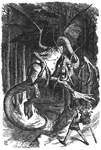 Prose writers can be as conscious of what sounds go together and the pictures they paint as poets are.
Prose writers can be as conscious of what sounds go together and the pictures they paint as poets are. Use the words below as Lewis Carroll did in Jabberwocky, interspersing them with real words. You don't need to write a poem (but you can if you want!) You can use them in a story. Don't try to use all the words! Pick and choose the ones that sound good to you. Add endings as needed (eg., -ly to make adverbs, -ed or -ing or whatever necessary to make the right tense verb.)
Rather than pay attention to the beginning sounds as in alliteration or the ending sounds as in rhyme, listen to the sounds inside the words. For instance bimarian misqueme sounds better than pication misqueme because the "m"s in the first echo each other but pication would go with something with a "k" or "g" sound (they're both said at the back of the throat) or strong "a" sound (well, assuming you're pronouncing it as piCAYshun! If you've come up with a different pronunciation it might go with something else better.)
They are all real words and came from Compendium of lost words
amorevolous
aporrhoea
bimarian
caprizant
cibosity
drollic
egrote
foppotee
hemerine
historiaster
jecorary
jumperism
kexy
miliaceous
misqueme
myriander
orgiophant
pication
pigritude
plenisphere
ponask
prandicle
pudify
quadrimular
rendling
roblet
sacricolist
scaevity
scathefire
schismarch
slimikin
soleated
sospital
starrify
tauroboly
temerate
thural
tremefy
urette
vacivity
vanmost
venialia
welmish
woundikins
xenization
yelve
More
There's a physical reason why some sounds go together. With practice you'll just unconsciously feel that sounds using the same part of the mouth seem to go together. But I like lists so I'll include the list from the exercise. If you pay attention to where your tongue is, or what part of your mouth you're using or whether your nose is involved when you say the following letters, you'll see why they're listed together.
Dentals (means teeth): t, d, thHere's the poem example Karen Swenson wrote in the book:
Labials (means lips): b, p
Gutturals (back of the throat): g, k, ng
Labiodentals: f, v
Sibilants (they hiss!): s, z, sh, ch, zh, j
Nasals (nose): m, n, ng, nk
Liquids: l, r
Noun: ocaShe says: "To break this down a bit: oca and moaned are paired for their "o" sound; night picks up the nasals in moaned and dump. In the next line the nasals of among match with the "on" of rhonchused and the "n" in cankered. "C" marches through the line from cars to rhonchused to cankered."
Verb: dextran, rhonchus, umbles
Adjective: maravedi, saccade
Adverb: pavid, tectum
The oca moaned all night in the dump
among cars rhonchused, cankered with
the maravedi dust. Dextraning
pavvidly in moonlight it
woke neighbors who umbled tectumly
down to the pit with guns and baseball bats,
a saccade crowd bent on murder.
From A Lewis Carroll Carol, an exercise by Karen Swenson in The Practice of Poetry: writing execises from poets who teach, edited by Robin Behn and Chase Twichell.
1 comment:
With bimarian hemerine Estarria
wore her roblet of sospital to pudify the Tauroboly.
The historiaster within her sought to starrify and tremefy,
but the foppotee paused and pulled away.
While deep within the drollic regions of her aporrhoea, Rendling,
that Ogriphant of Pigritude, that Temerate of Jecorary,
soleated the Welmish, bringing the plenisphere to yelve.
Post a Comment